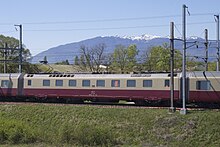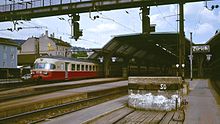SBB RAe TEE II
| SBB RAe TEE II | |
|---|---|
|
RAe TEE II 1053
|
|
| Numbering: | 1051-1055 |
| Number: | 5 |
| Manufacturer: | SIG , MFO |
| Year of construction (s): | 1961 (1051-1054) 1966 (one additional intermediate car) 1967 (1055) |
| Retirement: | 1995-2000 |
| Axis formula : | 2'2 '+ 2'2' + (A1A) '(A1A)' + 2'2 '+ 2'2' + 2'2 ' |
| Length over buffers: | 149,760 mm (six parts ) 125,334 mm (five parts ) |
| Height: | 4,210 mm |
| Width: | 2,840 mm |
| Total wheelbase: | 143,499 mm (six parts ) 119,074 mm (five parts ) |
| Service mass: | 296 t |
| Top speed: | 160 km / h |
| Hourly output : | 2,310 kW |
| Starting tractive effort: | 172.6 kN (15 kV) 188.3 kN (25 kV, 3 kV, 1.5 kV) |
| Continuous tensile force: | 81.6 kN (15 kV) 79.8 kN (25 kV, 3 kV, 1.5 kV) |
| Braking force: | 73.5 kN |
| Driving wheel diameter: | 1,110 mm |
| Impeller diameter: | 940 mm |
| Wheel diameter: | 940 mm |
| Power system : | 15 kV 16.7 Hz AC 25 kV 50 Hz AC 3 kV DC 1.5 kV DC |
| Power transmission: | Overhead line |
| Number of traction motors: | 4th |
| Translation levels: | 1: 2.34 |
| Seats: | TEE: 168 (1st class, six-part) 126 (1st class, five-part) 54 (dining car) EC: 84 (1st class) 108 39 (dining car) |
The RAe TEE II , later converted to RABe EC , is an electric express multiple unit of the Swiss Federal Railways (SBB) that was used on various TEE connections from the 1960s . It is designed for four power systems, which makes it universally applicable in Europe. This is why it is known in technical terms as a four-current multiple unit .
links
These multiple units were originally used on the following TEE connections:
- TEA «Gottardo» Zurich - Milan
- TEA «Cisalpin» Milano - Paris
- TEA “Ticino” Milano - Zurich
The trains were in use in a four-day cycle:
- Day 1: "Gottardo" Zurich - Milan and "Cisalpin" Milan - Paris
- Day 2: «Cisalpin» Paris - Milano
- Day 3: “Ticino” Milan - Zurich - Milan and “Gottardo” Milan - Zurich
- Day 4: Revision in Zurich
On May 30, 1965, the “Gottardo” started from Basel, but ended up in Zurich after the return journey from Milan. This led to an empty trip (after the inspection on the 4th day) to Basel. From September 30, 1979, this section was only served on weekdays before it was completely repealed on May 23, 1982. During the summer semester 1974–1979, the "Gottardo" was extended beyond Milan to Genova.
When the «Cisalpin» was switched to a locomotive-hauled train on May 26, 1974 and the «Ticino» was canceled on the same date, multiple units became available for the connections:
- TEA " Edelweiss " Zurich - Amsterdam
- TEA «Iris» Zurich - Brussels
The operation as TEE "Edelweiss" was discontinued on May 26, 1979, that of TEE "Iris" on May 30, 1981. As the last international TEE, the “Gottardo” drove for the last time from Milan to Zurich on September 24, 1988.
Technology / equipment
In addition to its multi-current capability, which made a stay at the national borders superfluous, the train only offered 1st class seats. For the first time women and men were able to use separate toilets. The washbasins were also equipped with cold and hot water taps. The ladies' room also had a separate make-up corner. The double-glazed car windows were equipped with electrically driven slat blinds, which ran between the inner and outer panes and could be operated individually by means of a pressure switch. The luggage could be stowed in the luggage racks in the generously designed entrance area. This increased the comfort in the car. The machine wagon was the only wagon to have two three-axle bogies and a side aisle due to its high weight - due to the axle load regulations applicable at the time - all the others were designed as open plan wagons with a 2 + 1 seating arrangement. The driver's cabs could be seen through a large pane of glass.
When there was a risk of avalanches , the RAe TEE II were to be found on the Gotthard route with a 120-tonne Ae-6/6 locomotive as the leader . Otherwise there would have been a risk that the light control car would have derailed on the tracks if it slid in snow.
After 30 years of operation, the trains were 1988 / 89 rebuilt and there were also seats in the second class. The classic color image ivory / red disappeared and they were kept in light gray / dark gray, which earned them the nickname “gray mouse”. The converted trains were used on the Zurich – Milan and Zurich – Stuttgart routes before they were only used as feeders to TGV trains between Bern and Frasne in recent years due to frequent malfunctions (transformer damage, broken axles) . After the damaged 1052 and 1054 had been broken off in Kaiseraugst in 1995 , the remaining trains 1051, 1053 and 1055 were finally withdrawn from the shuttle service and shut down at the end of 1999.
Handover to SBB Historic
The train with the number 1053 has been operated in the original TEE color scheme by SBB Historic (SBB Historical Heritage Foundation ) since the renovation in 2003 to 2009 . In 2012 a revision was carried out so that it can be used again. The electric anti-skid and anti-skid protection was replaced and the earlier multi-system capability of the drive was restored so that the historic TEE train can be used again on all European routes, as it was in 1961. In order to extend the range to include the new lines in Switzerland, SBB Historic decided in 2016 to occasionally upgrade the vehicle (currently planned from 2018/2019) with ETCS train protection technology . In order to raise part of the necessary capital, a patrons' association was founded.
Accidents
On October 5, 1962, TEE Cisalpin, traveling to Paris , suffered a serious accident near the Montbard train station . The almost brand new RAe TEE II 1053 of the SBB drove at 140 km / h into a tank car that had crashed on the opposite track and protruded into the profile , derailed, overturned and then rammed a stone guard's house. The accident left ten dead and eleven injured. Control car 1, damaged in the accident, was broken off and replaced by a new vehicle.
On June 26, 1964, the RAe TEE II 1052 drove as TEE Cisalpin on a level crossing between Vaux-et-Chantegrue and Labergement-Sainte-Marie in a truck loaded with bitumen , with three fatalities and 20 injured.
literature
- Robert Guignard, Klaus von Meyenburg: The electric Trans-Europ-Express trains of the SBB . In: Schweizerische Bauzeitung , Volume 80 (1962), Issue 13 E-Periodica (PDF; 23.8 MB).
- Louis-Henri Leyvraz: The four-stream multiple units RAe-TEE II 1051-1055 of the SBB . In: Swiss Railway Review . 06/1988. Minirex AG, p. 207 (8 pages, 12 images), ISSN 1022-7113
- The RAe-TEE 1053 is driving again . In: Eisenbahn-Revue International , Issue 7/2003, ISSN 1421-2811 , pp. 310-312.
- Maurice Mertens: Les Trans Europ Express (Seconde edition). La Vie du Rail, Paris 1987, ISBN 2-902808-21-6 .
- Maurice Mertens: Trans Europ Express . Alba, Düsseldorf 1987, ISBN 3-87094-114-6 .
- Hans-Bernhard Schönborn: The TEE trains in Switzerland. Luxury trains for Europe . GeraMond, Munich 2002, ISBN 3-7654-7122-4 .
- Christian Zellweger: TEE - icon of luxury trains . AS, Zurich 2003, ISBN 3-905111-95-0 .
Web links
- Bruno Lämmli: SBB RAe TEE II No. 1051-1055 from
- RAe TEE II TEE CLASSICS
- Page to RAe TEE II SBB Historic
- Pictures of the RAe TEE II in railfaneurope.net
- In-Ku Bulletin 28: Swiss Trans-Europ-Express (PDF; 223 kB)
- Jernbane.Net SBB: RAe TEE II / RABe
Individual evidence
- ↑ Snow chaos in the Alps . In: Swiss Railway Review . No. 4 . Minirex, 1999, ISSN 1022-7113 , pp. 125-135 .
- ↑ eisenbahn-magazin , 4/2012, p. 23
- ↑ Completion of the work TEE (PDF) Stadlerraid media release Bussnang, March 27, 2014
- ↑ Patrons' club “RAe TEE II 1053” brochure SBB Historic
- ↑ Le "Cisalpin" déraille: 3 mort 20 blessés, dont 2 Lausannois. (Le Temps - archives historiques) Gazette de Lausanne, June 27, 1964, p. 16 , accessed on November 18, 2013 (French).




